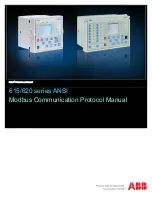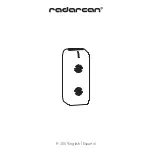
4.4
Ethernet Global Data (EGD)
The EGD protocol on the UDH is used for Mark VIe controller to Mark VIe HMI (running WorkstationST application), or for
Controller to Controller communications, and is configured using the ToolboxST application for the Mark VIe controller and
the WorkstationST application. Controller data configured for transmission over EGD is separated into groups called
exchanges
. Multiple exchanges make up
pages
. Pages can be configured either to a specific address (unicast), if supported, or
to multiple consumers at the same time (broadcast or multicast), if supported.
Note
IONet EGD transmissions occur between controller and I/O packs. IONet EGD communication is transparent to the
user, requiring no specific configuration by the user. An IONet EGD report can be generated in ToolboxST to provide
network status values for all IONet communication displayed in the current component and reflects totals of the controller
exchange. For further details, refer to the
ToolboxST User Guide for Mark Controls Platform
(GEH-6700), the section IONet
EGD Report.
Each page is identified by the combination of a Producer ID and an Exchange ID. The consumer recognizes the data and
knows where to store it. EGD allows one controller component, referred to as the producer of the data, to simultaneously send
information at a fixed periodic rate (frame rate) to any number of peer controller components, known as the consumers. This
network supports a large number of controller components capable of both producing and consuming information.
The exchange contains a configuration signature, which displays the revision number of the exchange configuration. If the
consumer receives data with an unknown configuration signature, it makes that data unhealthy. If a transmission is
interrupted, the receiver waits three periods for the EGD message, after which it times out and the data is considered
unhealthy.
EGD Communications Features
Feature
Description
Example types of
communication
Supervisory data is transmitted periodically at either 480 or 960 ms.
Controller data is transmitted to the HMI at frame rate.
Controller to Controller data is transmitted at 40 ms.
Message Type
Broadcast – a message sent to all stations on a subnet
Unicast – a directed message to one station
Multicast – a message sent to a group of destinations simultaneously in a single transmission
Redundancy
Refer to the section
Controller Redundancy to Prevent Loss of Communication
Sizes
Each exchange can contain a maximum of 1400 bytes of data (or payload). Pages can contain
multiple exchanges. The number of exchanges within a page and the number of pages within an
EGD node are limited by each EGD device type. The Mark VIe controller does not limit the
number of, exchanges, or pages.
Message Integrity
Ethernet supports a 32-bit CRC appended to each Ethernet packet.
Reception timeout is determined by EGD device type. The exchange times out after an
exchange update had not occurred within four times the exchange period, using Sequence ID.
Missing/out of order packet detection
UDP and IP header checksums
Configuration signature (data layout revision control)
Exchange size validation
Function Codes
EGD allows each controller to send a block of information to, or receive a block from, other
controllers in the system.
Communication Protocols
GEH-6721_Vol_I_BP System Guide 109
Public Information
















































